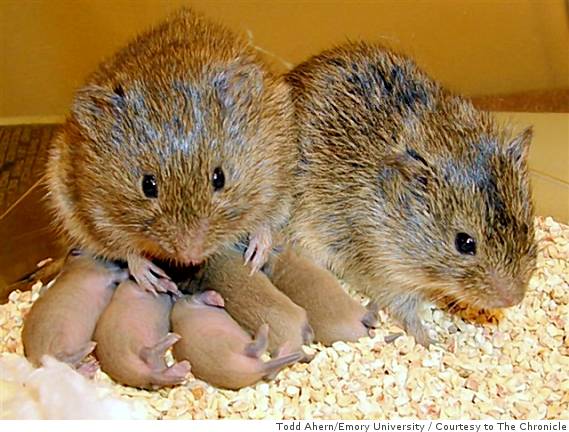The prairie vole is a small vole found in central North America that enjoys a most unusual love life. As soon as these finger-long creatures reach maturity, they lunge for the first available sex partner. From that point on, the male prairie vole has a continuous contact with its female, which lasts for all of their lives. This fidelity transcends even death: if the female prairie vole dies, the male does not look for a new partner.
This uniqueness in the prairie vole behavior is related to the oxytocin and vasopressin hormones. While copulating, the males produce vasopressin, the females, oxytocin, and these hormones affect the brain in such a way that the two partners develop a lifelong preference for one another. Furthermore, the oxytocin receptors of the female prairie vole brain are located more densely in the reward system, and in the male prairie vole, the gene for the vasopressin receptor has a longer segment. This segment is longer in other bonding animals (such as humans), and shorter in other nonbonding animals (such as chimpanzees).
When Emory’s University’s Tom Insel injected the male and female prairie voles with the appropriate hormones, they became lifelong mates even if they hadn’t first spent a night of passionate lovemaking together. The experiment also worked in the opposite direction. When the animals’ love hormone was blocked, there was none of the monogamy otherwise characteristic of the prairie vole. Insel taught house mice monogamy by planting a single gene from the prairie vole into their genetic material and thus equipping their brains with receptors for vasopressin and oxytocin. These house mice that are normally interested in each other only for the duration of sex turned to faithful partners*.
With humans, the mechanism of attraction, love and fidelity are more complicated. We, too, are predisposed toward monogamy. There is a Chinese saying that goes “One night of intimacy, a hundred days of conjugality.” What distinguishes us from prairie vole isn’t so much the basic mechanism of love but rather the freedom that we have in dealing with them and our addiction to novelty. Our environment also has a major influence on whether, when and how we bond with other people.
In the first “sweaty T-shirt” experiment, a Swiss zoologist, Claus Wedekind, set up a test of women’s sensitivity to male odors. He assembled volunteers, 49 women and 44 men selected for their variety of MHC gene types. He gave the men clean T-shirts to wear for two nights and then return to the scientists. In the laboratory, the researchers put each T-shirt in a box equipped with a smelling hole and invited the women volunteers to come in, one at a time, and sniff the boxes. Their task was to sample the odor of seven boxes and describe each odor as to intensity, pleasantness, and sexiness. The results were striking. Overall, the women preferred the scents of T-shirts worn by men whose MHC genes were different from their own**. The paring of different MHC genes benefits reproduction. According to evolutionary scientists, when people throw up their hands and say “it was just chemistry,” they may be on to a fundamental factor in mate choice.
Human love is undoubtedly far more complex than chemical reactions. But the emotions on which this is all based are programmed into us***. So it is worthwhile listening to our inner voices and taking cues from our sensory receptors when dating for marriage. Social and financial status compatibility may lead to a comfortable life. But a good biological match prepares the way for love. Lasting love requires continuous hard work and commitment from both parties. Friendship, open communication, acceptance, appreciation and fun loving are key ingredients to a happy and fulfilled union.
___________________________________________________________________________________
*The Science of Happiness by Stefan Klein
** http://www.pbs.org/wgbh/evolution/library/01/6/l_016_08.html
*** Insel and Young 2001


This is really interesting, You’re a very skilled blogger.
I have joined your rss feed and look forward to seeking more of your wonderful
post. Also, I’ve shared your web site in my
social networks!
April 27, 2014 @ 1:31 pm
I’ve been browsing on-line more than three hours lately, yet I never found any fascinating article like yours. It is pretty worth enough for me. In my opinion, if all webmasters and bloggers made good content as you probably did, the web might be a lot more helpful than ever before.
July 29, 2013 @ 11:37 pm
I am really thankful to the owner of this site who has shared this wonderful post at at this place.
July 16, 2013 @ 6:24 am
when i’m going to write in my blog, i come here and read your articles so i get inspired to write very well.
May 3, 2013 @ 4:09 pm
I really like what you guys are up too. Such clever
work and exposure! Keep up the great works guys I’ve included you guys to my blogroll.
May 2, 2013 @ 2:57 am
I was very pleased to find this site on google.I wished to say thank you for you with regard to this fantastic read!! I undoubtedlyliked each small little bit of it and I have you bookmarked to possess a take a look at new things you publish.
April 25, 2013 @ 6:35 am